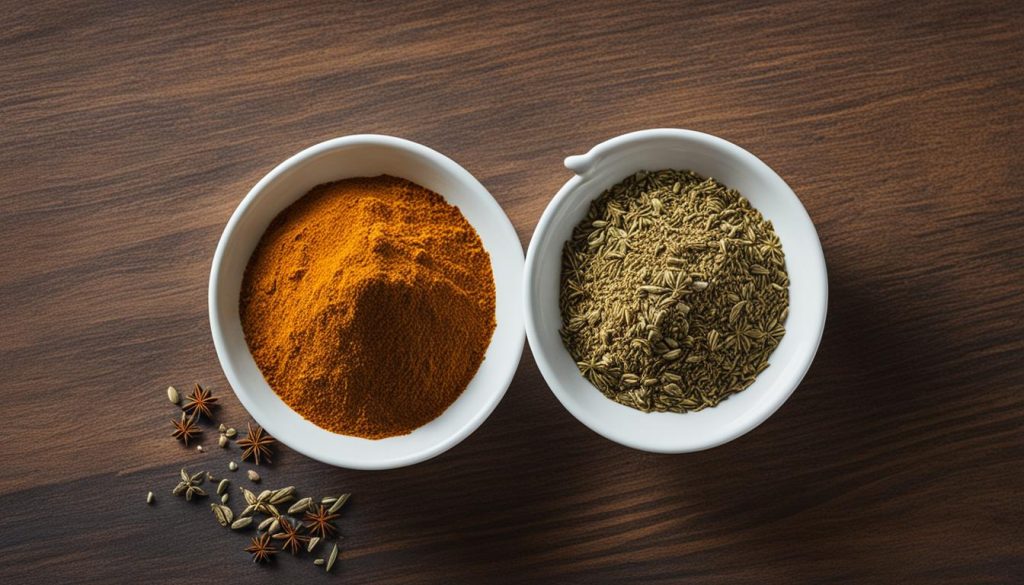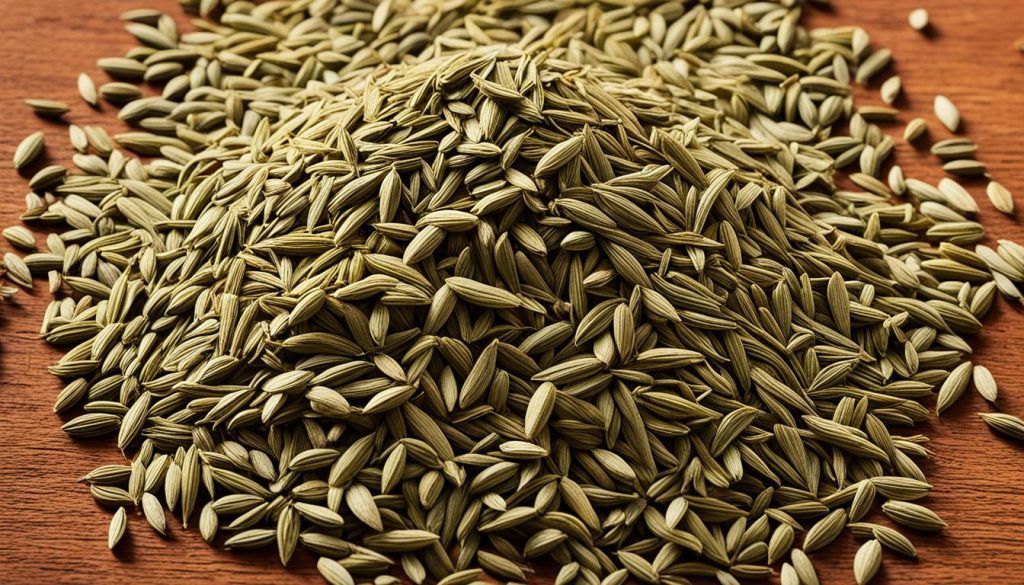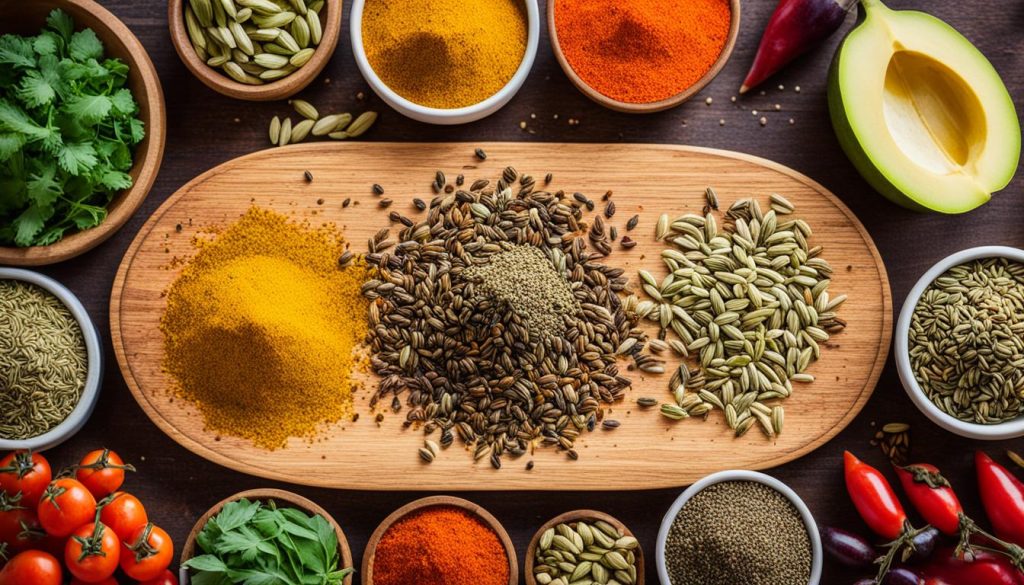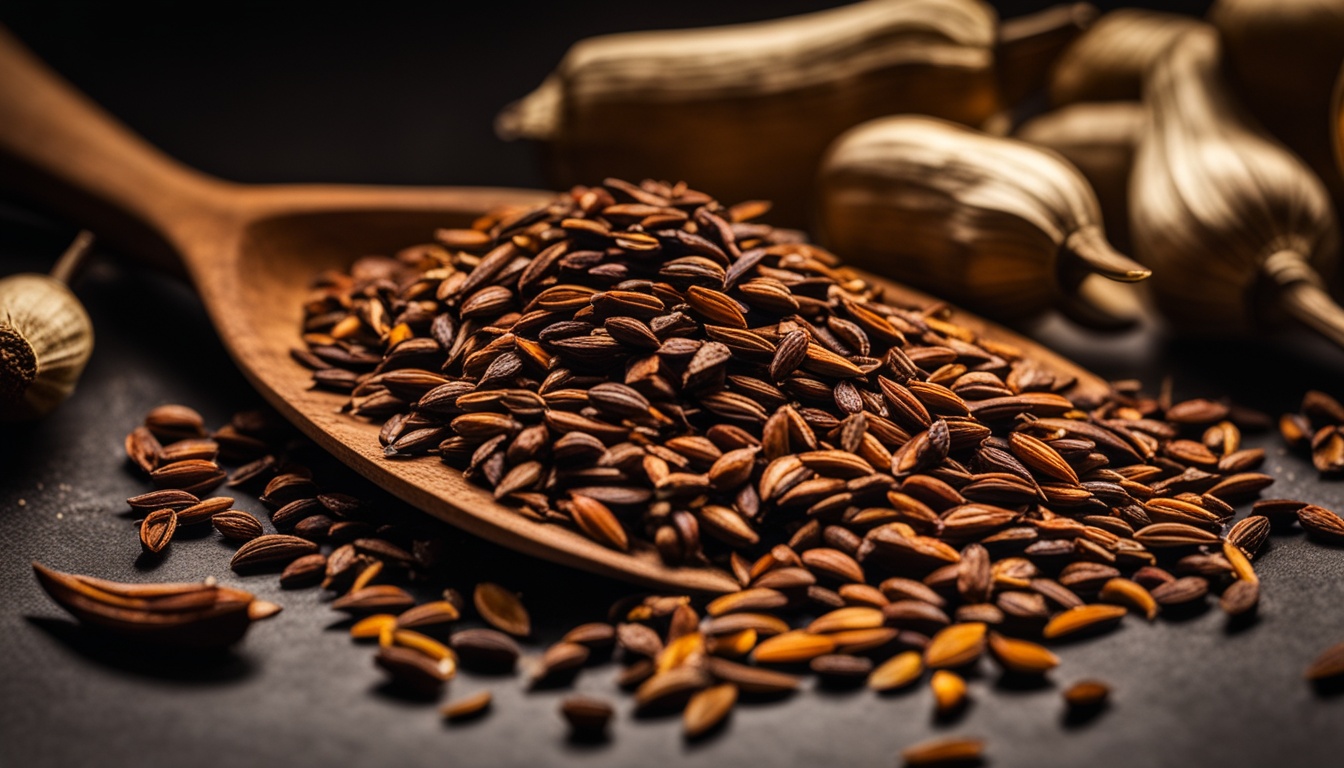I love cooking at home and I’ve found cumin (Cuminum cyminum) is amazing. It has a warm, earthy taste with hints of citrus. This spice has been a key ingredient in many cuisines for centuries.
Cumin can make many dishes better, like chili, barbecue sauce, curries, and rice. It’s known for its strong smell and taste.
Cumin comes from ancient Egypt and the Middle East. It’s not just for cooking; it’s also good for you. It helps with digestion and keeps you healthy.
If you like cooking or are just starting with spices, try cumin. It can make your food taste great. Use it in Indian curries or Mexican dishes for a unique flavor.
Cumin: The Spice That Defines Middle Eastern Cuisine
Cumin has been a key spice for centuries in the Mediterranean and Middle East. It’s a main part of traditional dishes, adding depth and a unique flavor. This spice is loved for its warmth in many recipes across the region.
Exploring Cumin’s Ancient Origins and Cultural Significance
Cumin has been valued for thousands of years. Ancient people in Mesopotamia and Egypt used it for health and cooking. Its smell and taste are a big part of Middle Eastern culture, making it a key spice in their food.
- Cumin’s history in the Middle East goes back to ancient Egypt, where it was used for cooking and in rituals.
- In ancient Mesopotamia, cumin was seen as a healing spice and used in medicine.
- The Israelites in the Bible era also saw cumin as important, listing it as one of the herbs to be given as a tithe.
“Cumin has been a staple in Middle Eastern cuisine for centuries, its unmistakable flavor profile becoming a defining characteristic of the region’s rich culinary heritage.”
Today, cumin is still a big part of Middle Eastern food. It adds a special smell and taste to many dishes, like rice pilafs, stews, and grilled meats. Its importance shows how spices shape our food and culture.

Ground Cumin vs. Cumin Powder: What’s the Difference?
I love exploring the differences between ground cumin and cumin powder. These spices have unique traits that change how your food tastes.
Unlocking the Secrets of Ground Cumin and Cumin Powder
Ground cumin is made by roasting cumin seeds and then grinding them. This method gives a deep, earthy flavor with a hint of citrus. Cumin powder is just ground cumin seeds without roasting. It tastes milder and more even.
Ground cumin looks darker and reddish-brown. Cumin powder is lighter. Ground cumin is coarser, while cumin powder is finer.
| Characteristic | Ground Cumin | Cumin Powder |
|---|---|---|
| Appearance | Darker, reddish-brown | Lighter in color |
| Texture | Coarser, more granular | Finer, silkier |
| Flavor | Rich, earthy, and slightly bitter with citrus notes | Milder, more consistent |
Ground cumin and cumin powder are great for different recipes. Use ground cumin in slow-cooked dishes for its strong flavor. Cumin powder is better for quick or delicate recipes.

Cumin is a spice that has the power to transform a dish, adding depth and complexity to the flavor profile.
Cumin is key in many cuisines, from Middle Eastern to Mexican. Knowing the differences between ground and cumin powder can open up new cooking possibilities. It can make your dishes stand out.
Unleashing Cumin’s Warm, Earthy Flavor
Cumin has been a key spice for centuries in many cuisines. It’s known for its unique taste. This spice adds a warm, earthy flavor to dishes, making them more complex. Its aroma is bold, spicy, and slightly sweet, adding depth to both savory and sweet foods.
Cumin goes well with many ingredients like coriander, chili peppers, garlic, onion, and cinnamon. This makes it a great addition to many dishes. It’s perfect for everything from Middle Eastern meals to Mexican dishes. Adding cumin can make any stew or meat dish taste better.
“Cumin’s earthy flavor profile is the backbone of many iconic dishes, adding an irresistible depth that simply can’t be replicated by other spices.”
Knowing how to use cumin’s flavor can make your cooking better. It’s great for adding depth to simple dishes or balancing spicy curries. The earthy flavor of cumin is a must-have for any kitchen.

The warm spice notes of cumin make it a versatile spice. It’s used in many cuisines, from Middle Eastern stews to Mexican marinades. Cumin can turn simple ingredients into something special. Let this spice’s warmth and earthiness open up new cooking possibilities for you.
Health Benefits of Cumin: Nature’s Powerhouse
Cumin is more than just a spice that makes food taste good. It’s a powerhouse of health, packed with nutrients and healing properties. It’s a natural wonder that should be in our diets.
Unlocking Cumin’s Nutritional Treasure Trove
Cumin is full of minerals like iron, magnesium, and calcium. These are key for healthy blood, strong bones, and body functions. It also has antioxidants that fight off harmful free radicals, lowering inflammation and protecting cells.
- High in iron, important for red blood cell production and oxygen transport
- Contains magnesium, which supports heart health and muscle function
- Provides calcium, essential for strong bones and teeth
- Abundant in antioxidants, guarding against cellular damage
Cumin is a nutritional powerhouse, offering many health benefits. It’s easy to add to our diets.
Cumin’s Digestive Superpowers
Cumin has been used for ages to help with digestion. Research now backs up its traditional use. It boosts digestive enzymes, making digestion smoother and easing bloating, gas, and constipation. Its anti-inflammatory effects also soothe stomach troubles.
| Nutrient | Amount per Teaspoon | % of Daily Value |
|---|---|---|
| Iron | 1.4 mg | 8% |
| Magnesium | 5 mg | 1% |
| Calcium | 16 mg | 2% |
| Antioxidants | High | N/A |
Cumin’s nutrients and healing properties make it great for a healthy diet. Adding it to your cooking is a simple way to improve your health.

Cumin: Essential in Indian, Mexican, and Middle Eastern Dishes
Cumin is a key spice in many world cuisines. It’s found in Indian, Mexican, and Middle Eastern dishes. This spice adds a unique taste that makes food special.
In Indian cooking, cumin is a must-have in dal, a tasty lentil dish. It also adds flavor to hummus, a creamy dip from the Middle East. Without cumin, these dishes wouldn’t be the same.
In Mexico, chili con carne and other spicy dishes use cumin. It balances the flavors, making the dish stand out. Cumin is essential in these recipes, defining their unique tastes.
| Cuisine | Signature Dishes | Role of Cumin |
|---|---|---|
| Indian | Dal, Curries, Biryani | Adds depth, warmth, and earthy notes |
| Middle Eastern | Hummus, Stews, Tagines | Enhances the nutty, creamy flavors |
| Mexican | Chili con Carne, Enchiladas, Tacos | Balances the spicy and savory elements |
Whether you’re making an Indian curry, a Middle Eastern stew, or a Mexican dish, cumin is key. It brings warmth and complexity to every bite. Cumin connects these cuisines, making them special.
Toasting Cumin: The Secret to Unlocking Its Full Potential
I love cooking at home and have found toasting cumin seeds or ground cumin changes everything. It’s a simple trick that makes this spice taste and smell amazing. Toasting cumin brings out rich, earthy flavors that take your dishes to the next level.
A Simple Technique for Enhancing Cumin’s Aroma and Taste
Toasting cumin is easy and makes a big difference. Just heat a dry skillet over medium-low heat and add cumin seeds or ground cumin. Stir it constantly to avoid burning until it smells great and looks a bit darker, usually in 2-3 minutes.
This step of toasting cumin releases its aroma and boosts its flavor. The heat brings out warm, earthy notes. These add depth and complexity to your food.
Whether you’re making chili, biryani, or salsa, toasted cumin can change everything. Next time you use this spice, toast it first. You’ll see how this simple trick can transform your dishes.
Versatile Cumin: From Spice Blends to Marinades and Rubs
Cumin is a spice that adds a special touch to many dishes. It’s not just for Middle Eastern and Indian food. This spice can make many dishes taste better. It’s great in spice blends, marinades, and rubs.
Incorporating Cumin into Your Diet: Tips and Tricks
Adding cumin to your food can make your meals more interesting. Here are some ways to use this spice:
- Sprinkle ground cumin on roasted vegetables like carrots, potatoes, or cauliflower for a savory, earthy twist.
- Add cumin to your favorite chili or taco seasoning blend to give it an authentic, smoky note.
- Incorporate cumin into marinades for meats, fish, or tofu, allowing its robust flavor to permeate the ingredients.
- Experiment with cumin in baked goods like breads, crackers, or even cookies for a surprising and delightful flavor combination.
- Blend cumin into smoothies or sprinkle it over avocado toast for a nutrient-dense boost.
Using cumin can open up new flavors in your cooking. It can make your everyday dishes taste better.
“Cumin is the backbone of so many global cuisines. Its earthy, warm notes can truly transform a dish.”
Cumin is great for making spice blends, marinating meats, or adding a new twist to recipes. It’s very versatile. Let cumin help you be more creative in the kitchen.
The Perfect Pairing: Cumin Combinations That Elevate Dishes
Cumin is a spice that goes well with many flavors. It makes dishes taste great. Whether you’re making a Middle Eastern dish or a spicy Mexican meal, cumin is a key ingredient.
Storing Cumin: Preserving Its Freshness and Potency
Storing cumin right is important to keep its flavor. Whole cumin seeds can last up to four years in a cool, dark place. Ground cumin stays fresh for about six months if stored well. Always keep cumin away from sunlight and moisture to keep it flavorful.
Cumin pairs well with spices like coriander, chili peppers, and garlic. It also goes great with onion, tomatoes, cinnamon, and cloves. Trying out these mixes can make your dishes taste amazing. Cumin adds a warm, earthy flavor to your food.

